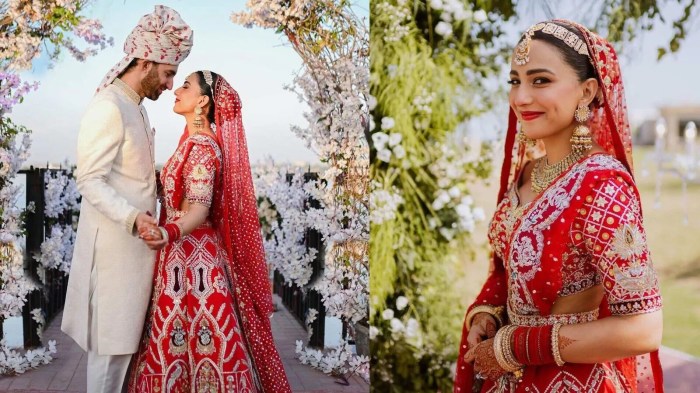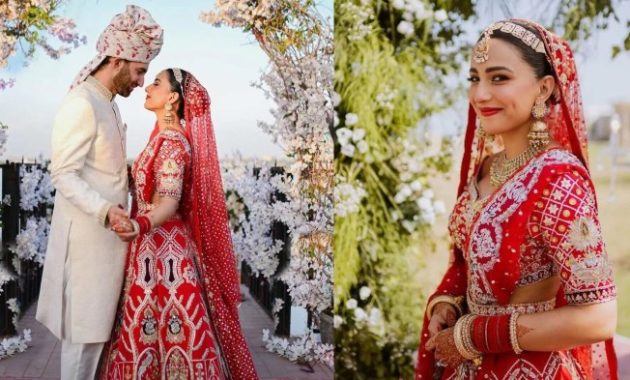Pakistani Pink Wedding Dresses: A Tapestry of Tradition and Modernity
The vibrant hue of pink holds a special significance in Pakistani weddings, symbolizing joy, femininity, and new beginnings. This exploration delves into the rich history and evolving trends of Pakistani pink wedding dresses, examining their cultural context, design evolution, and the artistry involved in their creation. We will traverse the spectrum of traditional styles, modern interpretations, and the complementary elements that contribute to the overall bridal aesthetic.
Traditional Pakistani Wedding Dresses Styles
Pakistani wedding dresses, particularly those in pink, boast a captivating history, reflecting the nation’s diverse cultural heritage and evolving fashion sensibilities. Their evolution mirrors the changing socio-economic landscape and artistic influences over the centuries.
Regional Variations in Pink Wedding Dress Styles
The diversity of Pakistan is reflected in the regional variations of its wedding attire. While pink remains a popular choice across the country, the styles and embellishments differ significantly. For instance, the bridal dresses of Sindh often feature intricate mirror work and vibrant embroidery, contrasting with the more subdued elegance of those found in Punjab, which might prioritize rich silks and delicate threadwork.
Similarly, the Kutch region’s dresses often incorporate mirror embroidery and vibrant colors, while those from Balochistan tend to feature more geometric designs and earthy tones, even within the pink palette.
Traditional Embroidery Techniques on Pink Wedding Dresses
Traditional embroidery techniques are integral to the beauty of Pakistani pink wedding dresses. Aari work, known for its delicate chain stitches, creates intricate floral patterns and motifs. Zardozi, employing gold and silver threads, adds a touch of opulence. Resham embroidery, using silk threads, produces rich textures and vibrant colors. Each technique adds a unique dimension to the garment, reflecting the skill and artistry of the embroiderers.
Traditional Fabrics and Their Suitability for Pink Wedding Dresses
| Fabric | Origin | Properties | Suitability for Pink |
|---|---|---|---|
| Silk | Various regions of Pakistan and internationally | Luxurious, lustrous, drapes well | Excellent; enhances the vibrancy of pink |
| Velvet | Historically from Persia, now widely produced | Rich texture, luxurious feel, warm | Suitable for darker shades of pink, adds depth |
| Net | Widely available | Lightweight, sheer, delicate | Ideal for lighter shades, allows for intricate embroidery |
| Chiffon | Various regions | Lightweight, flowing, sheer | Excellent for lighter, pastel shades of pink |
Modern Interpretations of Pakistani Pink Wedding Dresses
Contemporary designers are reimagining traditional styles, infusing modern aesthetics into the classic silhouettes and embellishments. This blend of tradition and innovation results in breathtaking creations that appeal to modern brides while honoring cultural heritage.
Key Trends Influencing Modern Pakistani Pink Wedding Dresses
Current trends reflect a fusion of traditional techniques with contemporary designs. Minimalist aesthetics are gaining popularity, alongside the use of unconventional silhouettes and fabrics. The incorporation of pastel shades and metallic accents adds a modern touch to the traditional pink palette.
Modern Fabrics and Embellishments in Pakistani Pink Wedding Dresses
Modern designers are incorporating a range of innovative fabrics and embellishments. Lace, tulle, and organza are often combined with traditional silks and velvets. Embellishments include delicate beadwork, sequins, and 3D floral appliqués, adding layers of texture and visual interest. Laser-cut details and intricate patterns are also becoming increasingly popular.
Designs of Three Modern Pakistani Pink Wedding Dresses
Here are three conceptual designs illustrating the versatility of modern Pakistani pink wedding dresses:
- A-line Gown with Pastel Pink Tulle and Floral Appliqués: A flowing A-line silhouette crafted from pastel pink tulle, adorned with delicate 3D floral appliqués in varying shades of pink and ivory. The bodice features intricate beadwork and subtle sequin detailing. This design exudes a romantic and ethereal vibe.
- Fitted Mermaid Gown with Deep Pink Velvet and Zardozi Embroidery: A form-fitting mermaid gown in a rich, deep pink velvet. Intricate zardozi embroidery in gold and silver threads decorates the bodice and train, creating a luxurious and regal look. This design is perfect for a bride seeking a glamorous and sophisticated aesthetic.
- Modern Lehnga Choli with Fuchsia Pink Silk and Laser-Cut Details: A contemporary take on the traditional lehnga choli. The lehnga (skirt) is crafted from fuchsia pink silk with laser-cut details creating intricate geometric patterns. The choli (blouse) features a modern neckline and subtle sequin embellishments. This design blends tradition with contemporary flair.
The Significance of Pink in Pakistani Weddings
The color pink in Pakistani weddings transcends mere aesthetics; it carries deep cultural and symbolic weight, representing various auspicious aspects of the occasion.
Cultural and Symbolic Meaning of Pink in Pakistani Weddings
Pink often symbolizes joy, femininity, and new beginnings, reflecting the celebratory nature of Pakistani weddings. It’s associated with auspiciousness and good fortune, making it a popular choice for bridal attire and wedding decorations.
Use of Pink in Different Aspects of Pakistani Wedding Celebrations
Pink is not limited to the bride’s attire. It is frequently used in wedding decorations, such as floral arrangements, tablecloths, and even the lighting. Pink-themed sweets and desserts are also common, further emphasizing the color’s significance.
Variations in Pink Shade Preferences within Pakistani Communities
Shade preferences for pink wedding dresses vary across different Pakistani communities. Brides from some regions might favor lighter, pastel shades, while others might opt for bolder, deeper pinks, reflecting regional traditions and personal preferences.
How Pink Shade Reflects the Bride’s Personality or Wedding Theme
The shade of pink chosen often reflects the bride’s personality and the overall wedding theme. A bride with a romantic disposition might prefer a pastel pink, while a more bold and confident bride might choose a vibrant fuchsia. The choice can also align with the wedding’s overall aesthetic, such as a rustic or modern theme.
Jewelry and Accessories for Pakistani Pink Wedding Dresses
Jewelry and accessories play a crucial role in completing the bridal look, enhancing the beauty of the pink wedding dress and reflecting the bride’s personal style.
Types of Jewelry Traditionally Worn with Pakistani Pink Wedding Dresses
Traditional jewelry includes elaborate necklaces, bangles, earrings, and rings, often crafted from gold and adorned with precious stones. The specific styles and designs vary depending on the region and the bride’s family traditions. Heavy necklaces, often with intricate designs, are a common feature, along with bangles that create a jingling sound as the bride moves.
How Jewelry Choices Complement Different Shades and Styles of Pink Dresses
The choice of jewelry should complement the shade and style of the pink dress. Lighter shades of pink pair well with delicate gold jewelry and pastel-colored gemstones. Deeper pinks can be enhanced with bolder gold pieces or jewelry featuring red or ruby accents.
Suitable Accessories for Different Pink Wedding Dress Styles
- Shoes: Heels in metallic gold or silver, or embellished shoes matching the dress’s embroidery.
- Veils: Sheer veils in ivory or matching pink, or intricately embroidered veils.
- Handbags: Small clutches in gold, silver, or a shade of pink that complements the dress.
- Jewelry: Matching earrings, necklaces, bangles, and rings in gold, silver, or precious stones.
Visual Description of a Bride in a Pink Wedding Dress with Complementary Jewelry and Accessories
Imagine a bride radiant in a fuchsia pink silk lehnga choli. The choli, intricately embroidered with gold zardozi, accentuates her slender waist. The flowing lehnga cascades around her, showcasing the delicate laser-cut details. She wears a heavy gold necklace adorned with rubies, complementing the deep pink of her dress. Matching bangles chime softly with each movement.
Delicate gold earrings and a small ruby-encrusted clutch complete the ensemble. Her makeup is soft and glowing, enhancing her natural beauty, and her hair is styled in a sophisticated updo, adorned with delicate pink flowers.
Pakistani pink wedding dresses, vibrant and richly adorned, offer a stunning contrast to the traditional Western bridal aesthetic. The choice of color reflects cultural significance and family traditions, a far cry from the prevalence of white, which, as detailed in this informative article on the origin of the white wedding dress , became popular relatively recently. Ultimately, both traditions showcase the beautiful diversity in wedding attire across cultures.
Makeup and Hairstyles to Complement Pakistani Pink Wedding Dresses
Makeup and hairstyle choices play a crucial role in completing the bridal look, harmonizing with the pink wedding dress and enhancing the bride’s natural beauty.
Makeup Styles to Enhance the Beauty of a Bride in a Pink Wedding Dress
Makeup should enhance the bride’s features without overpowering the dress. A soft, glowing look is ideal, focusing on a natural complexion with subtle contouring and highlighting. Eyes can be accentuated with warm-toned eyeshadows and a touch of mascara. Lipstick should complement the shade of pink in the dress, perhaps a nude or rosy tone.
Popular Hairstyles that Pair Well with Different Types of Pink Pakistani Wedding Dresses
Hairstyles should complement the dress’s silhouette and the bride’s overall aesthetic. A sophisticated updo works well with elaborate dresses, while loose curls or braids can suit simpler styles. The hair can be adorned with flowers, jewelry, or other accessories that match the dress and jewelry.
Adapting Makeup and Hairstyle Choices to Different Skin Tones and Hair Textures
Makeup and hairstyle choices should be adapted to suit different skin tones and hair textures. For example, brides with darker skin tones might opt for richer, warmer makeup shades, while those with lighter skin tones might choose softer, more pastel shades. Hairstyles should be chosen based on hair length, texture, and the bride’s preference.
Step-by-Step Guide on Applying Makeup Suitable for a Pakistani Bride in a Pink Wedding Dress

Source: livemint.com
- Start with a clean, moisturized face. Apply primer to create a smooth base.
- Apply foundation that matches your skin tone. Blend thoroughly.
- Use concealer to cover any blemishes or dark circles.
- Apply a light layer of powder to set the makeup.
- Apply a warm-toned blush to the apples of your cheeks.
- Apply eyeshadow in warm tones, such as browns, golds, or coppers.
- Apply mascara and eyeliner to enhance your eyes.
- Apply lipstick in a shade that complements your dress.
Questions Often Asked
What are some less traditional pink shades used in Pakistani wedding dresses?
While bright fuchsia and rose are popular, softer shades like blush pink, dusty rose, and even mauve are increasingly seen, offering a more subtle yet elegant look.
How can I find a Pakistani designer who specializes in pink wedding dresses?
Online searches, browsing bridal magazines focusing on South Asian fashion, and attending bridal shows are excellent ways to discover talented designers. Word-of-mouth recommendations from family and friends are also invaluable.
Are there specific types of jewelry that don’t work well with pink dresses?
While most jewelry complements pink, overly heavy or dark pieces might clash with lighter shades. Consider the overall tone of the pink (e.g., warm vs. cool) when selecting your jewelry’s metallic tones (gold, silver, rose gold).

